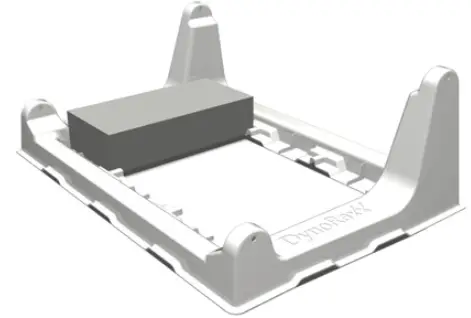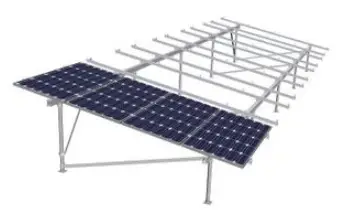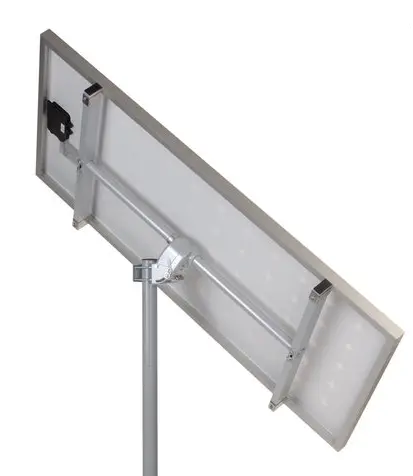In this quick guide, we’ll share the 5 best solar panel mounts that are out in the industry, currently.
While there are many ways to mount solar panels to your rooftop or your RV’s roof, some ways are the best ways, simply. Depending on your need and your situation, we can “hook” you up with the best mounts.
Based on our deep research and customer reviews, we take care of picking the most reliable and the most useful product that’s in, right now, so you won’t have to!
Let's check them out
Best Solar Panel Mounts
IRONRIDGE SGA XR1000 ROOF MOUNT RACKING KIT - $70
Overview
The IronRidge XR1000 is the add-on to the XR100 (I know, confusing product titles) that is meant to be combined with the ground mount to provide angles and elevation to the solar panels. The XR rails act as the structural backbone of the IronRidge family as a whole with the ground-mounted systems. Read more about it at bit.ly/31Wsguo
Life Length: The product comes with a 25-year warranty along with a guarantee to be free of impairing defects.
How It’s Manufactured: The IronRidge XR1000 is engineered with 6000-series aluminum alloy and protected with an anodized finish to prevent corrosion.
Cost: The cost of this frame is $70 to be added on to the original $60 in order for the solar panels to be angled.
Advantages: This product allows panels to be tilted for better power input of solar panels which relates to a higher output of electricity.
Disadvantages: The main base for the system, the XR100, is needed to add onto this product which is an additional $60.
Overview
The IronRidge Ground Mount system is a base system that mounts solar panels to the ground. Even though it’s got “roof mount” in the product title, this is just a base system that’s meant to ground your solar panels with additional brackets that you can purchase to mount to a rooftop. Check it out at bit.ly/3eaKTQ7
Life Length: The product comes with a 25-year warranty along with a guarantee to be free of impairing defects.
How It’s Manufactured: The IronRidge XR100 is engineered with steel and aluminum components to ensure durability.
Cost: The cost of the ground mount is a $60 add-on that is a must-have for ground mounting any solar panels to the ground.
Advantages: The frame comes with multiple foundations and array configuration options to be installed on most terrains.
Disadvantages: Even if not ground mounting, this kit is still needed for rooftop, angle mounting which costs another $70.

Overview
The DynoRaxx Evolution flat roof system featured components to provide a simple installation. The best part is that there are no tools needed since the design is universal and there are only three components to safely and securely flat mount your solar panels. Visit their website for more information at bit.ly/3oKxhzK
Ballasted System: Ballast is a common alternative used that is unable to penetrate the roof or the ground so that there’s no need for tools, holes, or damage to property.
How It’s Manufactured: The DynoRaxx Evolution features fiberglass components since they’re low-cost, lightweight, and extremely durable. The tool-less pivot clamps are made with 16 gauge 304 stainless steel.
Cost: For absolutely no tools involved and an easy installation, the solar mounting kit comes to your door for $50 plus shipping.
Advantages: Easy installation leads to no stressing out about drilling holes or staying on rooftops for more than 15 minutes-- just install, mount, and immediately start saving money on electricity.
Disadvantages: The weight of the system is pretty heavy as a whole which can make roof maintenance a pain in the butt. They’re also less flexible and can only be mounted one way that the instructions suggest.

Overview
The SunBeam system is a flat roof mount system that is robust, versatile, and specially engineered for multiple configurations. The mount takes full advantage of roof space to maximize system size which increases the rate of return-- the more space taken up, the more power that is received in return.
The system becomes a permanent part of the building it’s attached to which eliminates any abrasions, moss build up, and the need of system removal for roof repairs or re-roofing. Read more about it at bit.ly/2TCtxlA
Common Comments: The mount is easily customizable and adjustable for any tilt or degree of rotation desired along with clearance underneath for vents, pipes, and HVAC.
How It’s Manufactured: The product is engineered with highly corrosion-resistant anodized aluminum backed with stainless steel hardware-- lightweight for loads, yet strong for high, coastal winds.
Cost: The cost is estimated to be $15 for any customizable parts. The only downside is that there need to be multiple parts purchased for anywhere between $5-$15 depending on your solar panel and rooftop.
Advantages: The frame is easy to install with minimum attachments, and it’s all adjustable in every direction-- all of the pieces can be customized according to the user and the installer’s preferences.
Disadvantages: For a lot of solar panels, this project can get pretty expensive. This frame is mainly for those with just a few solar panels without any unnecessary confusion within the panels to ease installation.
SOLAR MOTOR SUNTRACER OG+ - $450

Overview
The SunTracer Tracker is great for cabins, tiny homes, RV’s, and for small solar water pumping systems. Since the tracker comes with the tracking pole along with two 200 Watt, equal-sized solar panels, the cost stays pretty low for a bundle of all items involved. Along with an easy installation process, this can save you some money depending on how many solar panels you’re planning on getting. If you like it, check more about it at bit.ly/34IQKsI
Life Length: The solar panels and the mounting kit comes with a 2 year guarantee time that there won’t be any issues within the panels. Besides that, if the motor is replaced every 8 years and the backup battery replaced every 3-5 years, the battery will last 15 years.
How It’s Manufactured: The steel arms and the aluminum arms together weigh around 25 lbs which is lighter than a lot of solar panels and trackers out there. The arms also provide an IP63 certified water resistance to an extent.
Lower Cost: Since the kit and bundle includes the solar tracker along with two 200 Watt solar panels, the whole bundle is $450 which is relatively lower than the average costs of these items separately.
Advantages: The ability to follow the sun around for maximum exposure is the best for maximum power output.
Disadvantages: For wanting more than one or two solar panels, this kit isn’t ideal since the set-up space will be very tricky to configure. Also, this product can only be ground mounted which may cause a problem for some folks.
TYPES OF MOUNTS
Tilt Leg Mounts
Tilt leg mounts are used in rooftop and ground-mounting for solar panels-- this set of mechanisms angles solar panels at different angles for the most perpendicular obtaining of sun rays in order to get the most power out of the solar panels. They’re cheap and a must-have for easy angling and weight distribution of the solar panels.
Roof Mounts
Roof mounts are exactly what they sound like-- they’re a set of mechanisms that is used to mount solar panels parallel to rooftops. Since most rooftops are already sloped at an angle, there’s no need for tilt leg mounts; you can just easily install roof mounts and solar panels to rooftops.
Fixed Ground Mounts
Fixed ground mounts are used in solar panels that are going to be set on the ground. Usually found in solar fields, these permanent structures can angle the solar panels to a certain degree or mount them to the ground perfectly flat. The only time fixed ground mounts are going to be seen used non-industrially would be in a camping setting where solar panels sit on the ground.
Pole Mounts
For solar panels that like to turn in more degrees of freedom, pole mounts can turn and twist solar panels to be perpendicular to the sun during any time of the day while using some power to track down the sun’s position in the sky-- these mounts can cost a little extra money, but they’re worth it since they bring in some extra juice and power.
Trackers
Trackers are mounts that sit on rooftops or on the ground, and they are similar to the pole mounts to where they follow the sun’s position in the sky for the most solar power due to perpendicularity. Trackers still use up some of the electricity to power itself, but the payoff is far larger than the power it takes to rotate and move the panel(s).
Mounts for Heavy Structure
There are specifically-made mounts for heavy solar panels and for the panels that are built for heavy duty. These panels are mainly used to withstand the extreme forces of nature and in cases where there are industrial solar panels being used, mainly the huge ones you spot while driving by solar fields.
QUICK FAQ’S
What is the best angle to mount a solar panel?
The best angle to mount a solar panel is easily the angle from the ground that makes the panel perfectly perpendicular to the sun’s position in the sky, so you can get the most out of your solar panel. Don’t want to manually move the solar panels? Buy trackers!
Is it cheaper to install solar panels on the ground?
It’s cheaper to install solar panels on the ground since the ground mounts are cheaper than the more complicated solar mounts, but by buying the cheaper flat mounts, you’d be sacrificing some sun power by not angling the panels; the rest is up to you!
How do you attach solar panels to the roof?
A lot of the mounts come with fully explained instructions that any person could read and install the mounts that are made for rooftop mounts.
Usually, involving some metal pipes and screws, the standard-sized solar panels can easily be mounted to rooftops with a little bit of labor.
Are solar panels too heavy for a roof?
Solar panels aren’t too heavy for a roof-- most solar panels out on the market are usually between 35-50 lbs which isn’t enough to collapse a roof. Each square foot of roof-work can usually hold 20 lbs while the average solar panel weighs about 2 lbs per square feet.
In other words and simpler terms, your rooftop is built to withstand around 6 feet of snow, so you’ll be fine with what you’ve got.
Is it worth tilting solar panels?
It is definitely worth tilting solar panels since when the sun’s position in the sky is directly perpendicular to the solar panel, that’s where the most power gets received and converted into usable electricity.
Flat mounting solar panels is okay, angling them is better, but tracking the sun with rotation and elevation is the best!
Can you mount solar panels vertically?
You can mount solar panels vertically, but it isn’t going to benefit you any more than horizontally mounting solar panels-- in fact, we recommend against vertically mounting solar panels.
For most of the day, the sun won’t be in range of the solar panel yet alone pointing directly at the panel.
How many solar panels do I need?
There’s a lot that goes into how many solar panels you’re going to need, enough to write a whole another article about them which is exactly why we wrote the article “What Can a 100 Watt Solar Panel Run?” for a complete breakdown of how much power you’ll truly need-- go ahead, and give it a read!
Wrapping Up
We hope that this quick and easy guide helped you with your next steps after buying a solar panel! There’s other accessories with solar panels, sure, but mounting solar panels is a necessity if the kit doesn’t come with your solar panel, but no fret! The installation can usually be done with one person.
As long as the solar panels aren’t too heavy, installing the solar panels on your house or RV should be easy. The products on the guide should help you decide what panels to buy and which ones you’re specifically looking for with your solar system. Go solar!


